A huge THANK YOU to all of the incredible young artists from around the globe who submitted their artwork to help us celebrate awareness and action for our ocean for World Oceans Day 2020 through art! We are so thrilled to share the below pieces of work, which serve as a reminder that artistic expression and creative communication play a crucial role in the ocean conservation movement, and that our next generation of ocean leaders is engaged and dedicated to finding solutions.
This project was spearheaded by Oceanic Global volunteer Sophie Goldstein (Fiorello H. LaGuardia High School’21), and created with the support of the Peace Boat and other Friends of World Oceans Day partners.
Marine Life
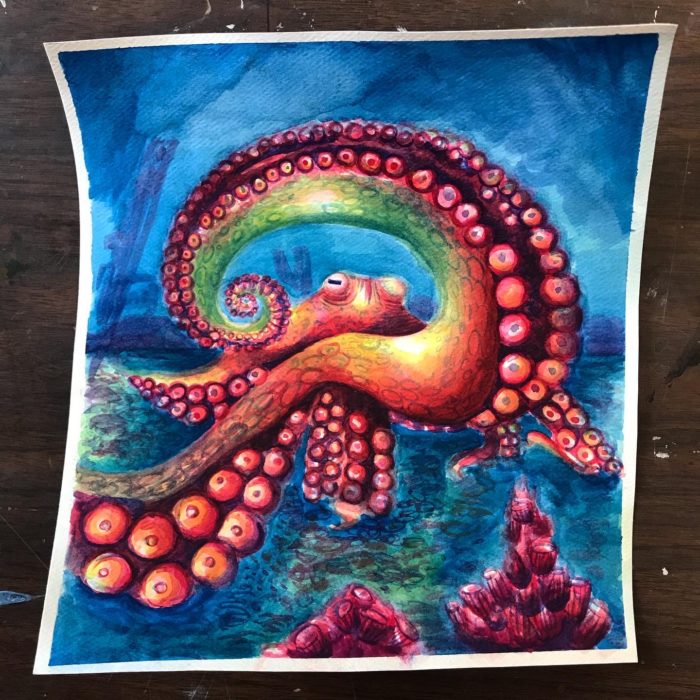
Sophie Goldstein (16): “Entering the Lair” 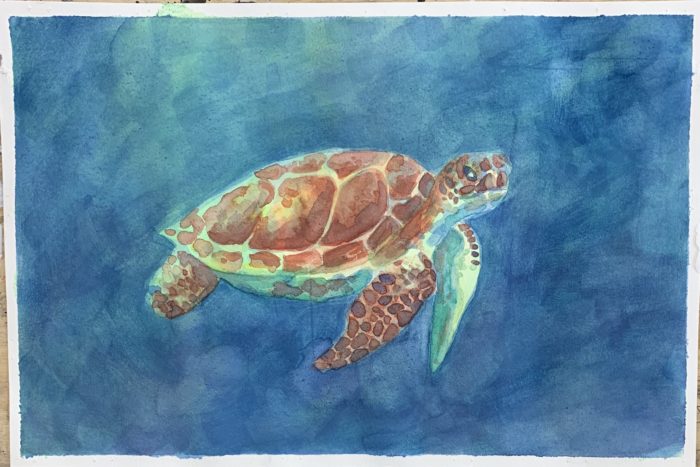
Conrad Goedicke (17): “Sea Turtle” 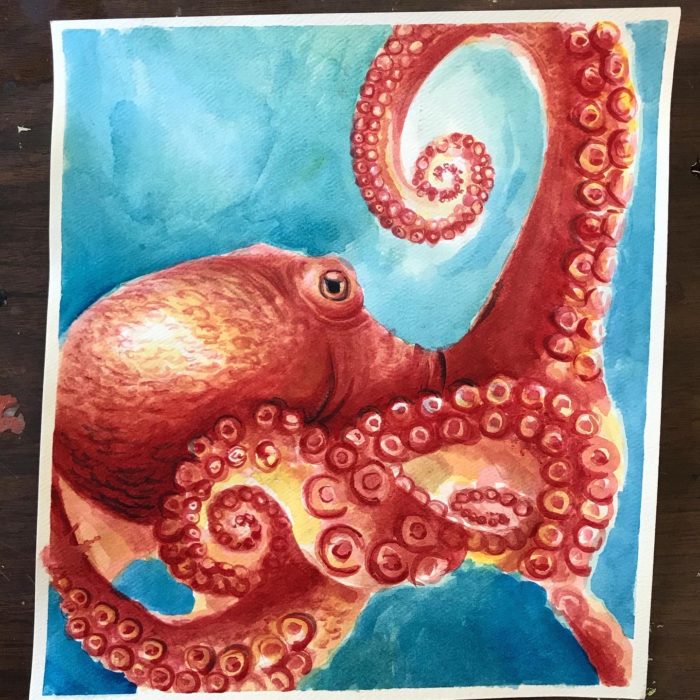
Sophie Goldstein (16): “Arms Out” 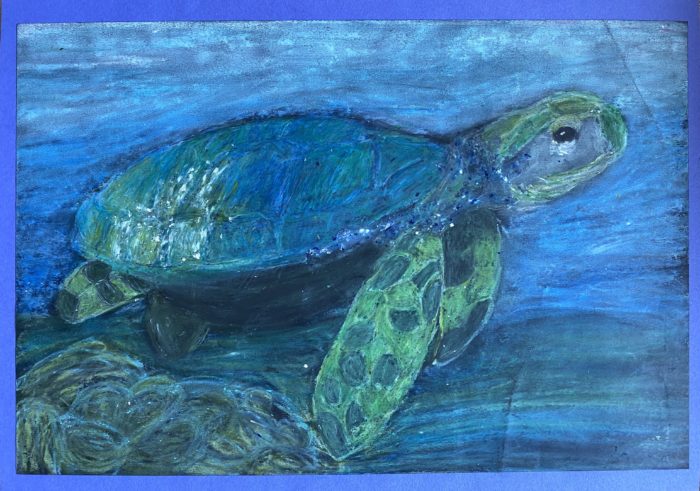
Sophia Lam (17):
“Sea Turtle”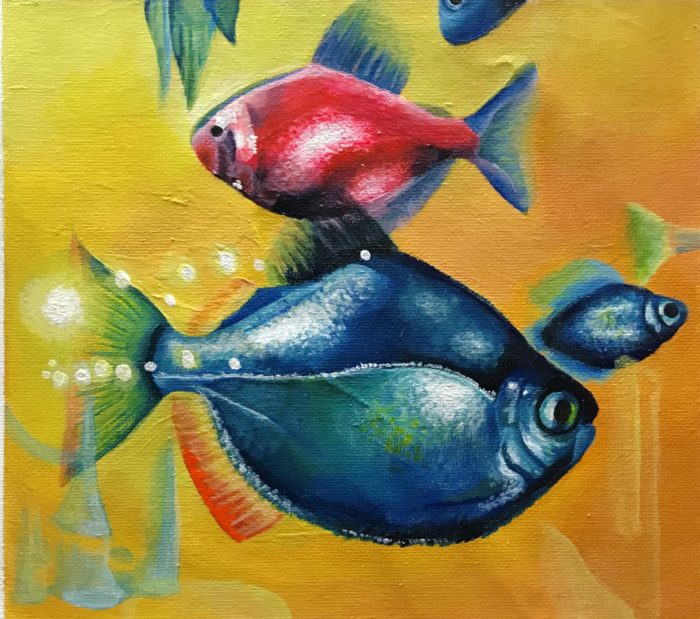
Sophie Goldstein (16): “Confined Beauty” 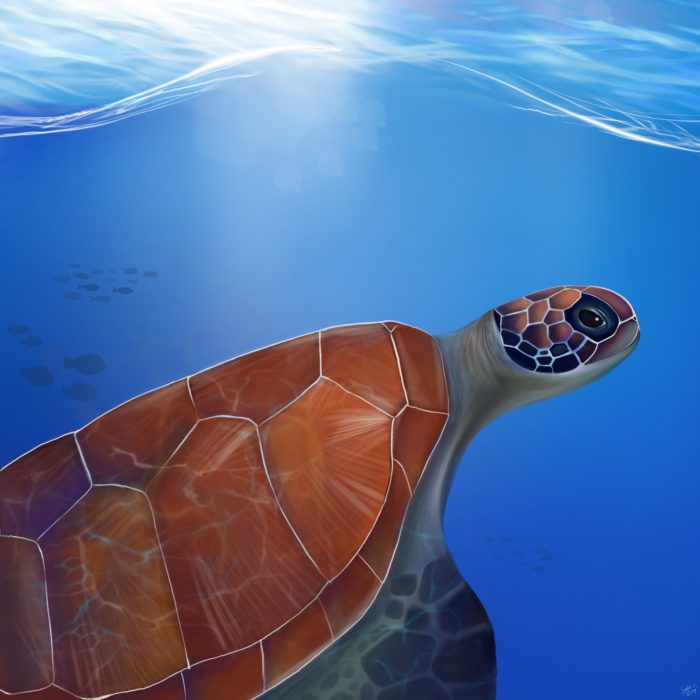
Sophia Wang (16): “Below the Sea Surface” 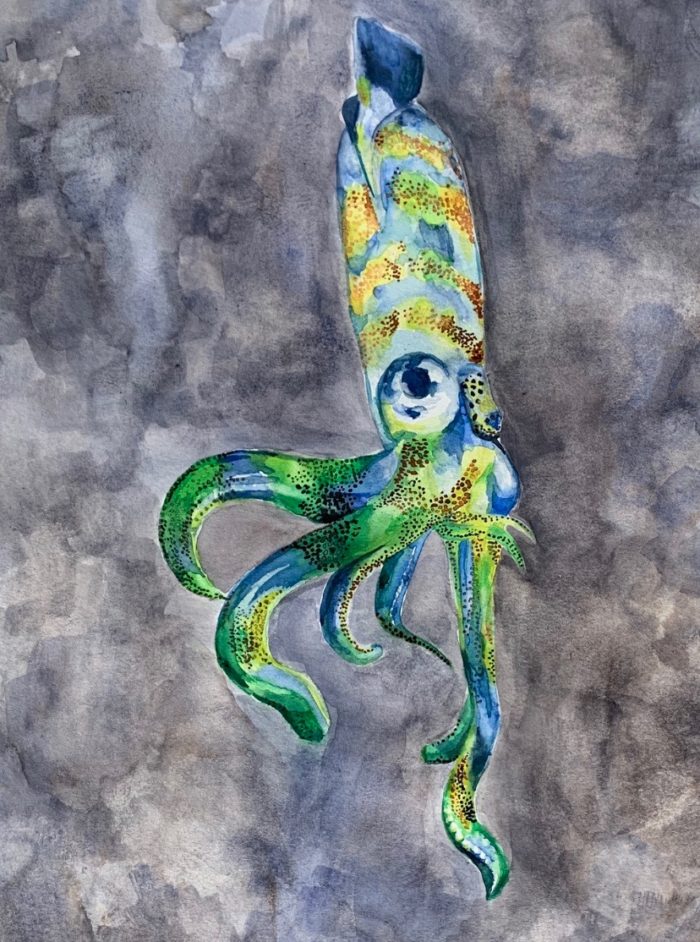
Aida Fraser (17):
“Bigfin Reef Squid”

Rana Fineman (16): “Anglerfish Sculpture”
Sophie Goldstein (16): “Entering the Lair”
Watercolor.
This a painting of an octopus in its habitat. It’s meant to be very exciting and colorful to lure the viewer in.
Conrad Goedicke (17): “Sea Turtle”
Watercolor.
I find the sea turtle to be an incredible animal that always appears to be so calm. So, in this watercolor piece my main goal was to try and portray that same tranquility I feel when looking at sea turtles.
Sophie Goldstein (16): “Arms Out”
TextWatercolor.
I wanted to showcase the beauty of ocean life using watercolor. This is a simple painting of an octopus. I wanted to highlight the movement of its arms and the different textures of its body.
Sophia Lam (17): “Sea Turtle”
Oil pastel.
Oil pastel drawing of a sea turtle.
Sophie Goldstein (16): “Confined Beauty”
Acrylic paint.
I went to a store once with my mom, and while I was waiting in line I saw a tank filled with beautiful fish in dirty water. I took out my camera and photographed the fish moving around in the murky yellow water. Later I decided to paint these fish because of their vibrant colors and shiny gills.
Sophia Wang (16): “Below the Sea Surface”
Procreate (digital painting App).
I was inspired by the majestic ocean life below the sea surface, specifically sea turtles, to create “Below the Sea Surface.” I decided to draw a sea turtle surrounded by some fishes. There is only one sea turtle to represent the fact that many species of sea animals and marine life in general are becoming endangered. Once abundant species of animals are now endangered or on the verge of becoming extinct. Species of sea turtles are endangered.
Aida Fraser (17): “Bigfin Reef Squid)
Watercolor.
Bigfin Reef Squid is more realistic and a study of patterns, shapes, and colors, and Lone Octopus is more subjective, and up to your interpretation.
Rana Fineman (16): “Anglerfish Sculpture”
White clay & glaze.
An earthenware sculpture of an anglerfish, a deep sea creature. It is formed from a cup with attached features, such as the large teeth and bioluminescent growth on the head characteristic of the anglerfish. It is made out of glazed white clay.
Oceanscape
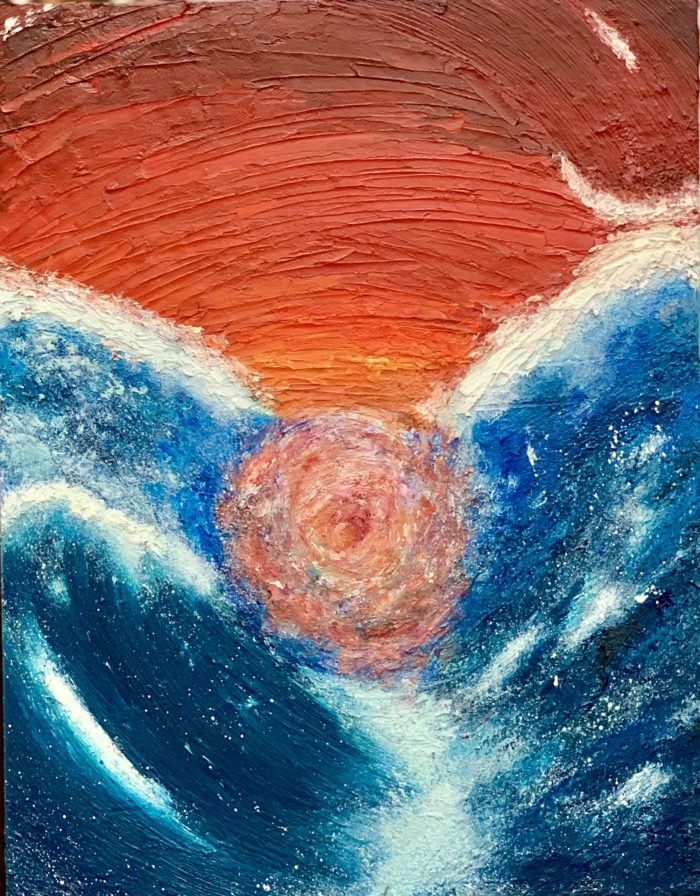
Kohei Kurihara (17): “Clash of the Sun and Sea” 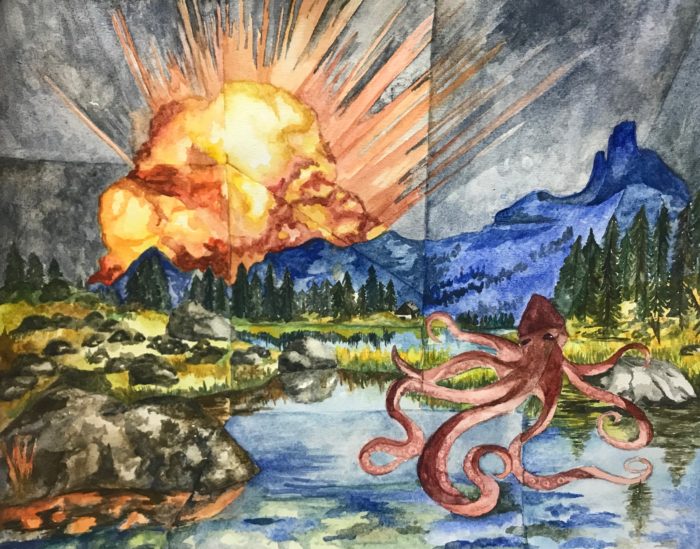
Aida Fraser (17):
“Lone Octopus”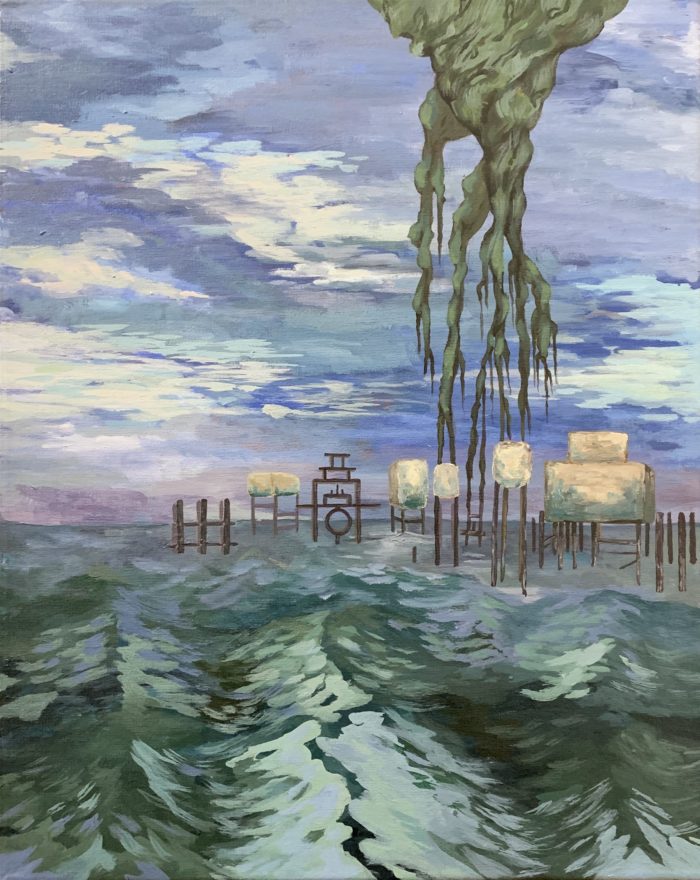
Michelle Shum (17): “Giant’s Cove” 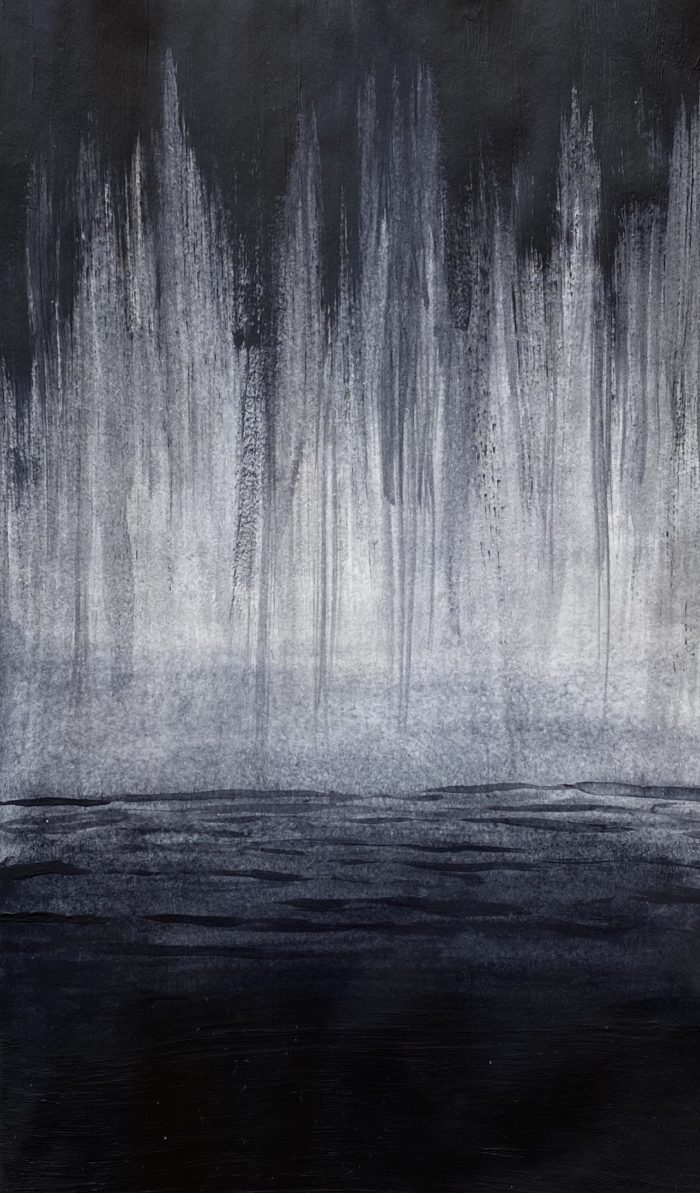
Anna-Sophia Wolk (15): “Depths of Desperation” 
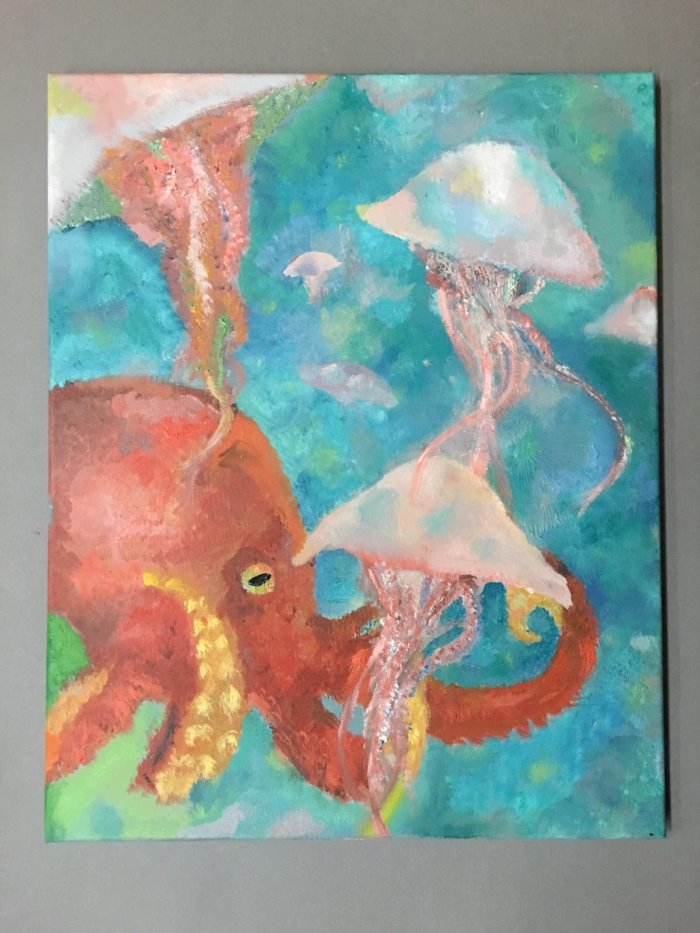
Chu Yi Lei (16):
“Jellyfish & Octopus”
Kohei Kurihara (17): “Clash of the Sun and Sea”
Oil on canvas.
This was one of my first oil paintings and so I decided to experiment my limits in them. From the experience I learned a unique way in creating texture in the waves and making foam, which was great for an ocean.
Aida Fraser (17): “Lone Octopus”
Watercolor.
As an artist I’ve always been so enthralled by the shapes and colors of tentacles. The movement captured by a painting / drawing or a photograph of squids and octopi is beautiful.
Michelle Shum (17): “Giant’s Cove”
Acrylic paint.
This is what it feels like to be in an isolated terrain surrounded by the largest portion of the world, which is the ocean. The ocean is as powerful as it is uncontrollable and a habitat maintaining the world’s biodiversity. The overwhelming blue tints create a solemn mood and tone down the objects in the background. Those blocks in the back resemble huts of an abandoned village living on water and the root from the sky reaching down is the link between the ocean and sky. It portrays an escape to another world.
Anna-Sophia Wolk (15): “Depths of Desperation”
Acrylic paint on paper.
Oceans, to me, have many connotations, both negative and positive. In this piece, I chose to demonstrate its more dark, mysterious side in a simplistic manner. It is rather an intimation. Nevertheless, the subject remains apparent, while allowing for a personal interpretation.
Chu Yi Lei (16): “Jellyfish & Octopus”
Oil paint on canvas.
The transparency of the oil paints on canvas captures the ocean’s vibrant colors from the luminescence of the sun. There are rainbows within the oceans, within the animals, within the waves. Please don’t let them fade away.
The Ocean in the Time of COVID-19
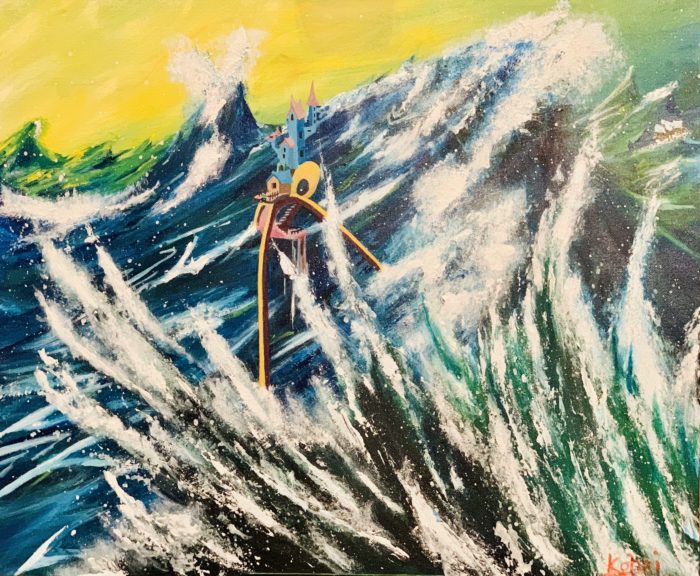
Kohei Kurihara (17): “Quarantine” 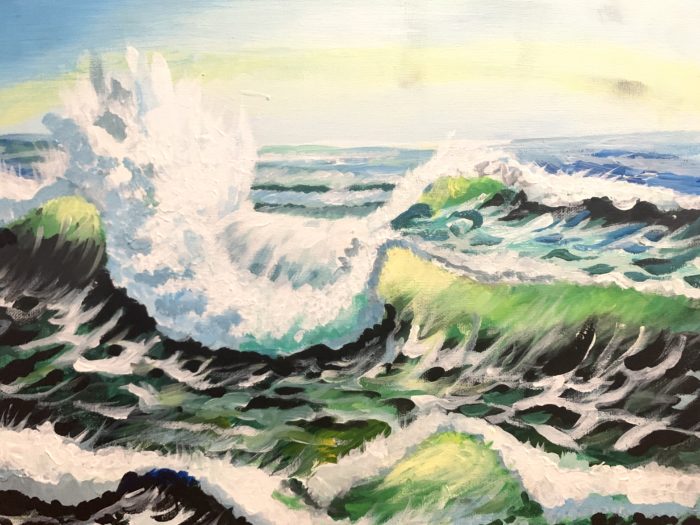
Silvia Lee (16): “Everlasting Peace” 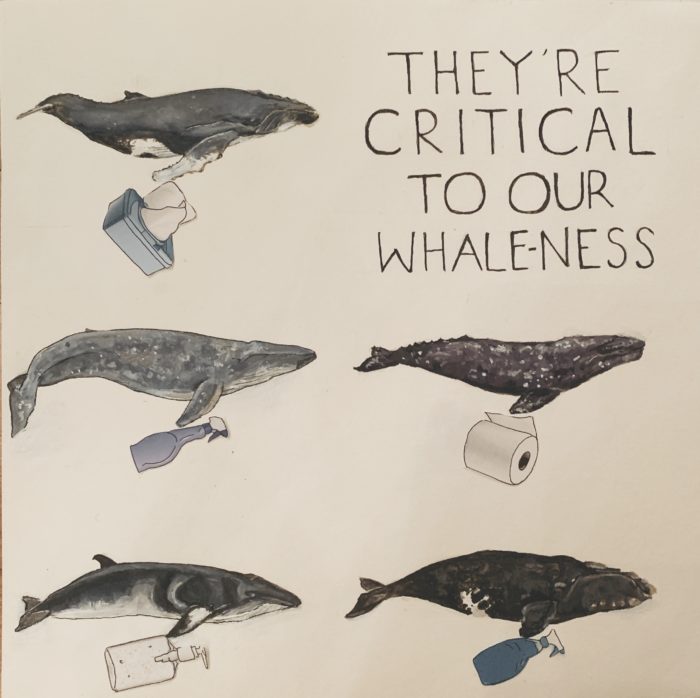
Aubrey Fowles (17): “They’re Critical to Our Whale-ness”
Kohei Kurihara (17): “Quarantine”
Acrylic on canvas.
I painted this to illustrate the quarantine state I am in. I isolated the house in an ocean to depict how far I had to be from civilization. I also painted the waves crashing and flowing ferociously to symbolize the Corona virus pandemic, because it is deadly just as a tsunami.
Silvia Lee (16): “Everlasting Peace”
Acrylic paint.
I painted a calm Ocean that represents an eternal peace and calmness even through tough situations.
Aubrey Fowles (17): “They’re Critical to Our Whale-ness”
Watercolor and ink on paper.
My work is about how the oceans and ocean life help humans be well (“whale”). Using symbols to represent our current situation with COVID-19, the piece reminds the viewer how ocean life constantly helps us, and people need to help ocean life in return.
Interconnected Systems
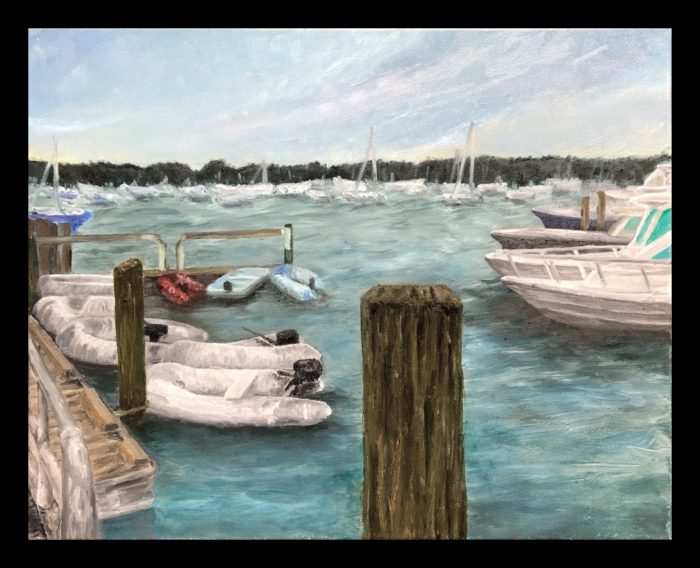
Christy Guo (16): “Vineyard Haven” 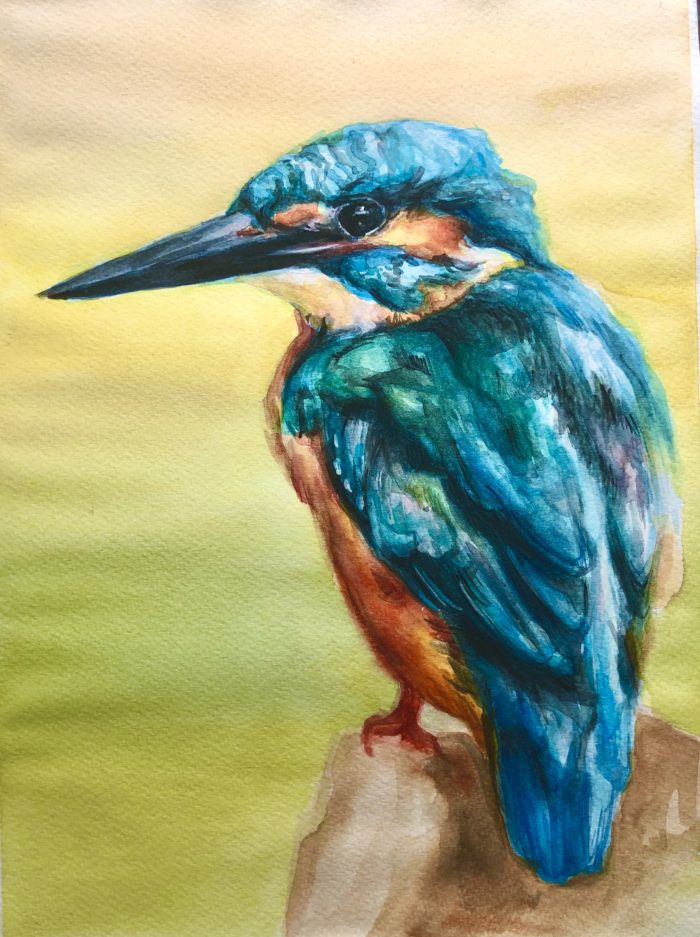
Xue Ying Huang (17): “Penitence” 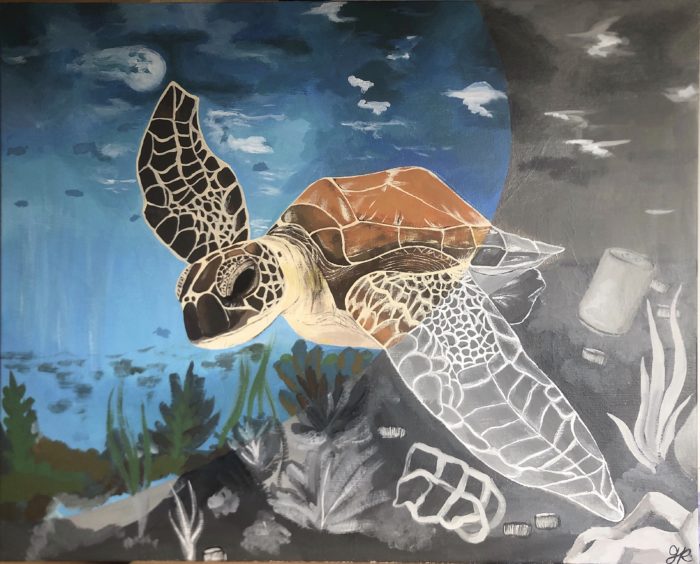
Geraldine Rojas (17): “Start with Change” 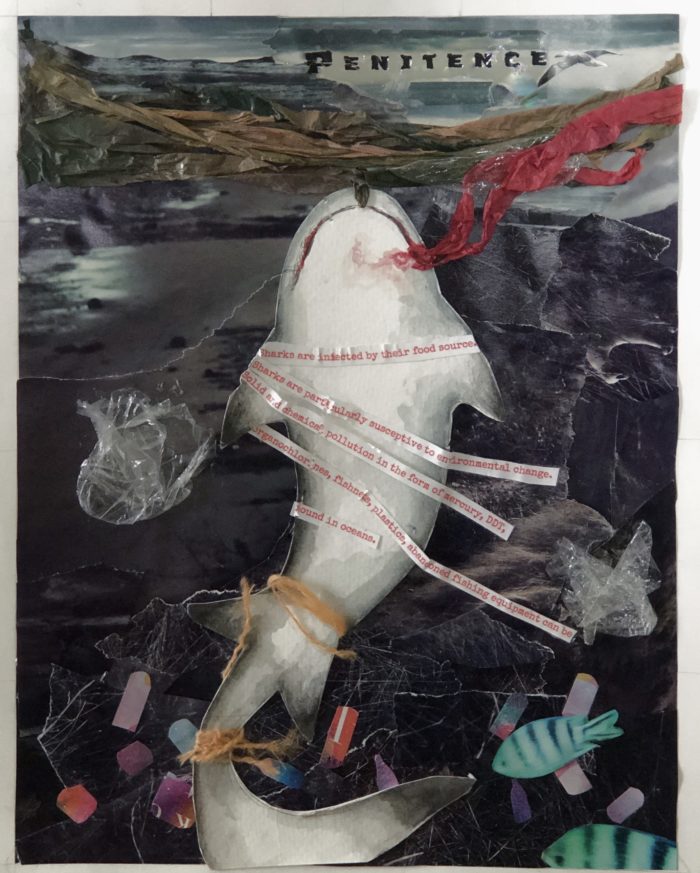
Yihong Chen (16): “Intertwined” 
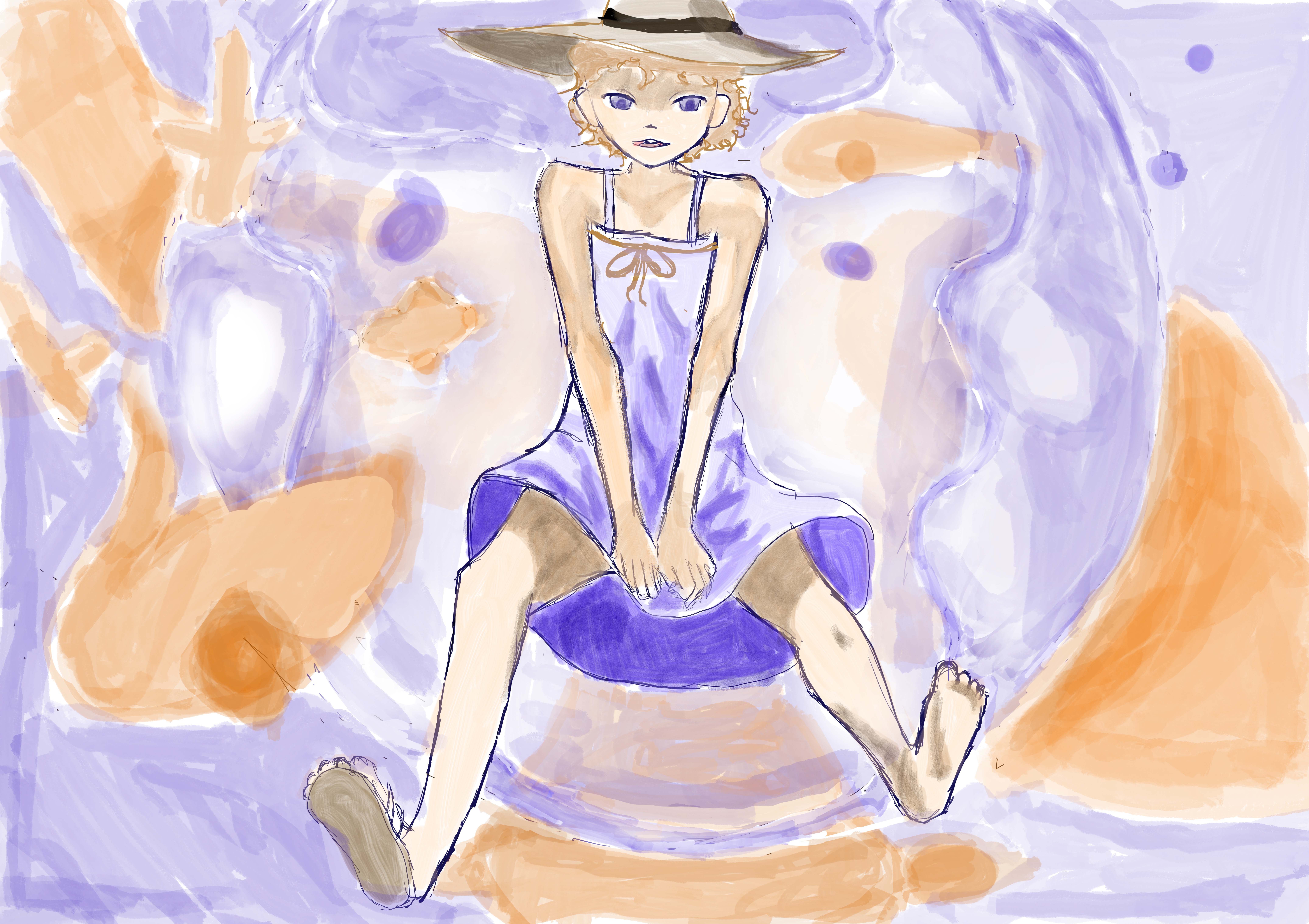
Kennedy Mensah (17): “County”
Christy Guo (16): “Vineyard Haven”
Oil paint.
This piece of work shows how many activities happen near our waters. There is life both in and out of the water and we need to protect and appreciate our planet’s oceans and other bodies of water. In this artwork, it emphasizes the influence of human life on the waters. Many have hobbies of sailing, but without providing proper care for sustainability for the waters, those activities become dangerous and unsafe from toxic chemicals and tons of trash. Not only will humans be affected, but the animal life underwater will also be harmed because animal behaviors can be ruined and the introduction of invasive species in the underwater habitats can alter ecosystems.
Xue Ying Huang (17): “Penitence”
Tissue paper, tape, plastic wrap, magazines, watercolor paper, and watercolor on Bristol paper.
The piece, Penitence, was created with the full intent of evoking guilt. Penitence contradicts our generalized view of oceans filled with vibrant marine life by establishing a dreary mood and an unmerciful depiction of ocean contamination, using dull-colored elements along with tape and plastic material.
Geraldine Rojas (17): “Start with Change”
Acrylic paint.
This piece was mostly inspired by all of the endangered sea creatures that are living in a dangerous environment on the daily, I wanted to show how change can really make a big impact.
Yihong Chen (16): “Intertwined”
Watercolor.
Although kingfishers are generally associated with rivers and lakes, which are mostly freshwater habitats, their survival depends heavily on the wellbeing of the oceans. A slight disruption in the water cycle, distribution of nutrients, water temperature, and many other factors can cause a great impact on the life of freshwater organisms, like kingfishers, who live far away from the seashores. It’s critical for us to keep in mind the vast intertwined environment and the life cycles of all organisms on earth, including humans. So saving the ocean not benefit ocean creatures, but also ensure the prosperity of other water-dependent organisms thousands of miles away, and ultimately, also benefit us humans.
Kennedy Mensah (17): “County”
Clip studio paint.
I’ve been working on this for a while now built of of a sketch that me and my friend did about 5 years ago, it’s been a blast doing this and I appreciate being asked for it.
Climate Change
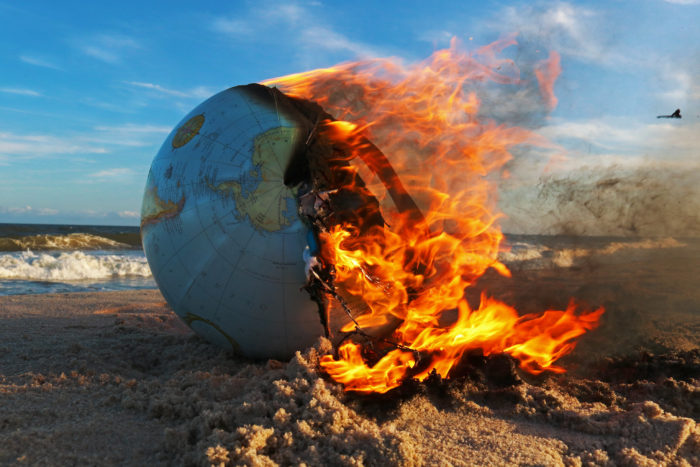
Mia Aharon (16): “The Ubiquity of Human Fingerprints on Earth” 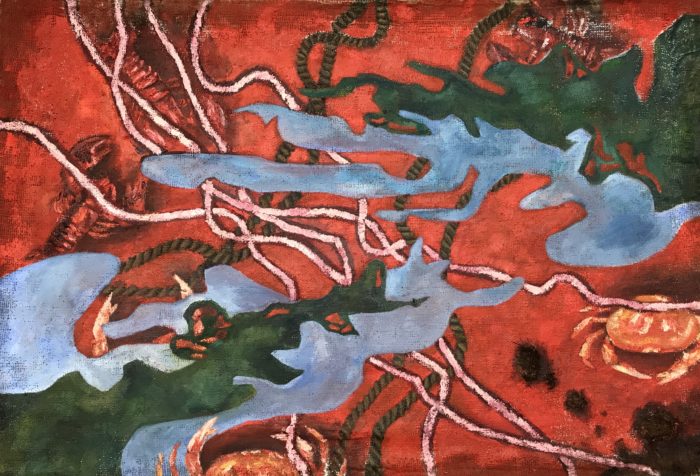
Sherry Weng (16):
“In Hot Water”
Mia Aharon (16): The Ubiquity of Human Fingerprints on Earth
Digital photograph.
This image depicts a slowly burning globe with a focal point on one of the poles, which symbolizes global warming, the progressive decay of the ozone layer, and the melting of the ice caps at our poles. The water being set far off in the distance highlights a solution to the fire that is present but too far away from being effective, and the combination of the water and sky being pristine highlights what we are losing while things slowly burn away.
Sherry Weng (16): “In Hot Water”
Oil paint on layered burlap.
The main issue I wanted to tackle in my work was global warming and its effect on the ocean. The title, In Hot Water, is an idiom that I believe describes our Earth’s current dire situation perfectly. The Earth is gradually warming up due to climate change, which has mostly been caused by our actions as humans. Humans produce so much waste and pollution each day, which clog up our oceans and destroy marine life. I attempted to display this waste in my art with the blue and green blobs, which symbolize oil spills and toxic algae blooms, respectively. These two phenomena are both caused by human actions and pollution and they hurt marine and freshwater life. I also exhibited the warming of the planet by making the background red to convey urgency and heat, as well as creating a burning effect on the edge of the canvas (burlap fabric) as a warning that if we continue to do nothing, our water sources will be destroyed. Also, I included species of marine animals we see almost every day, the lobster and the crab, because they seem so commonplace but if climate change and global warming don’t get more attention, they may also be destroyed in the future.
Marine Plastic Pollution
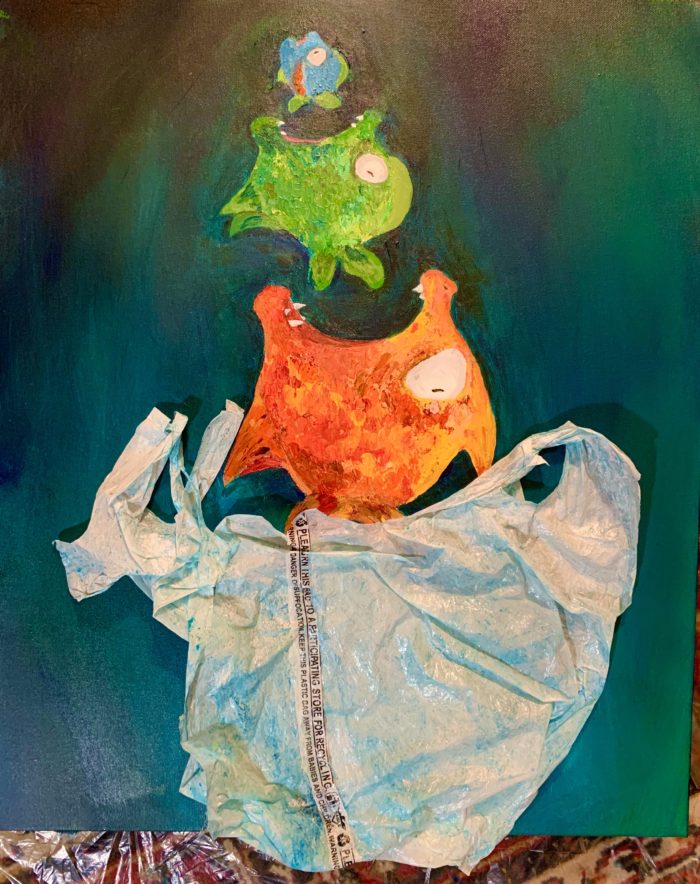
Kohei Kurihara (17): “Food Chain” 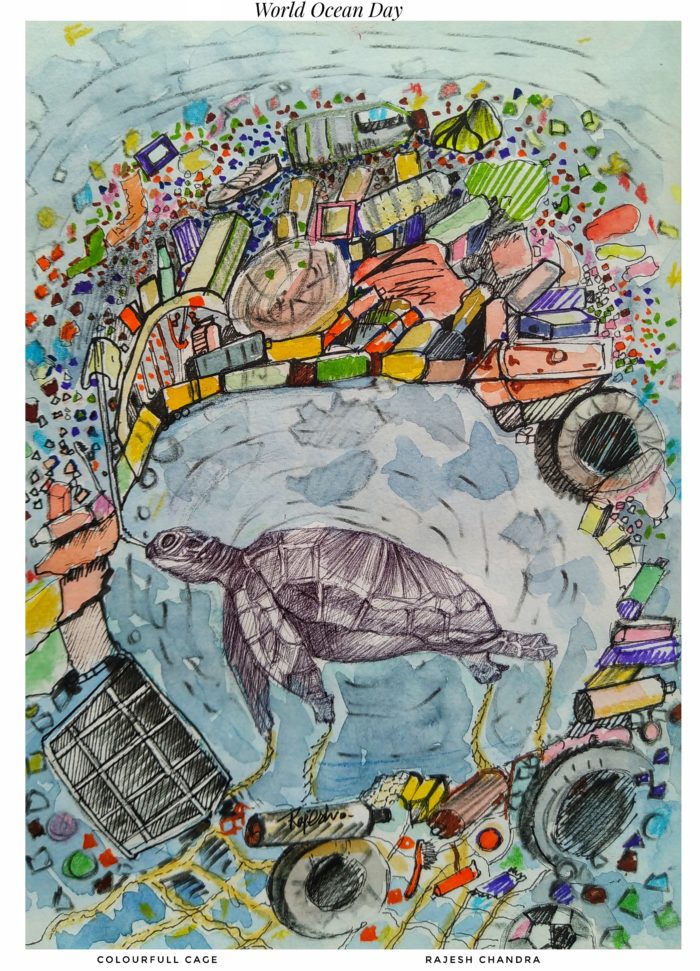
Rajesh Chandra (24, Teacher): “Colorful Cage” 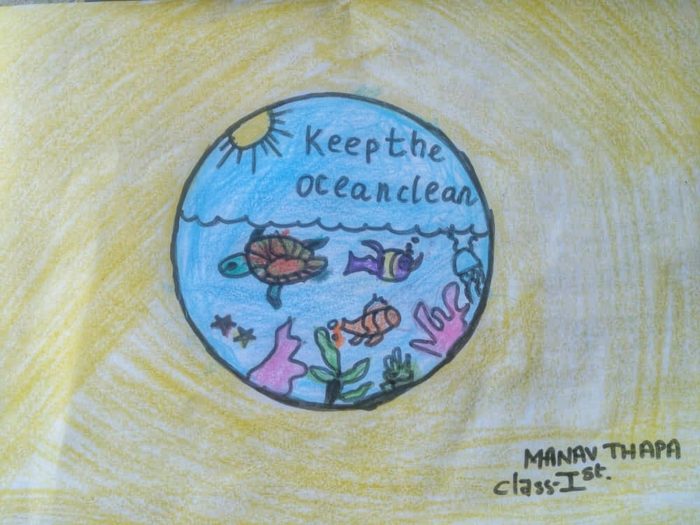
Shivansh Naithani (11): “Plastic Kills” 
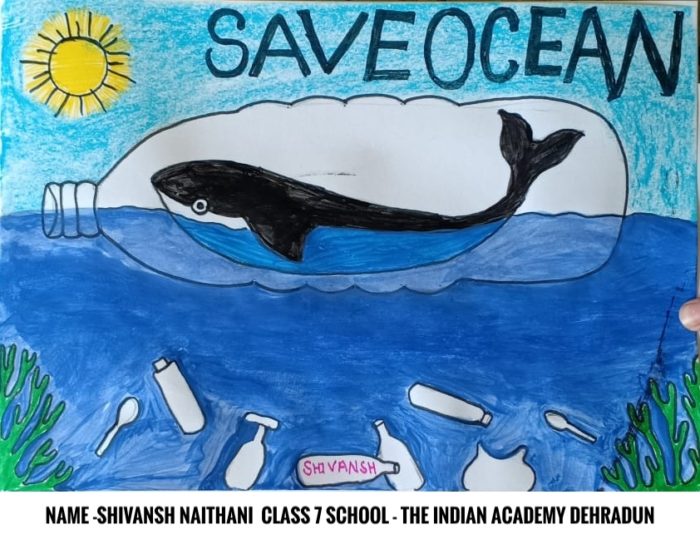
Manav Thapa (7):
“Keep the Ocean Clean”
Kohei Kurihara (17): “Food Chain”
Acrylic on canvas.
As the ocean becomes polluted each day, marine organisms are dying more and more. To illustrate this tragedy, I implemented the marine food chain and used a plastic bag as the top predator because plastic bags cause the majority of the death of organisms due to suffocation on plastic and bio magnification up the food web. I also used the bag since It’s large hole looked like a mouth.
Rajesh Chandra (24, Teacher): “Colorful Cage”
Watercolor.
I painted this artwork to show the current condition of water bodies not only ocean but river seas everywhere we see garbage colorful mess and less water less aquatic animals. We can make this earth a better place by using goods which are biodegradable like here in India we also use banana leaves as plates discarding disposable plastic plates in functions.
Shivansh Naithani (11): “Plastic Kills”
Watercolor & crayons on paper.
Shivansh wants to share with the world a message that plastic itself is a primary cause of pollution and depletion of biodiversity both on land and sea, plastic is the reason for the deaths of several species of flora and fauna. We need to find alternatives to single-use plastics.
Manav Thapa (7): “Keep the Ocean Clean”
Crayons on paper.
Manav wants to share with the world a message that plastic itself is a primary cause of pollution and depletion of biodiversity both on land and sea, plastic is the reason for the deaths of several species of flora and fauna. We need to find alternatives to single-use plastics.